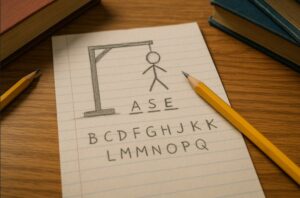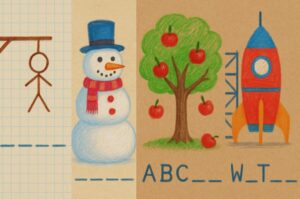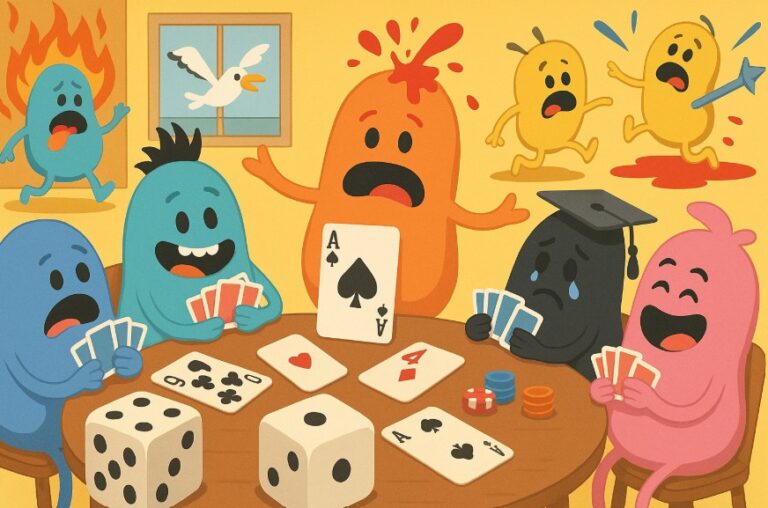Hangman is a classic word-guessing game that has entertained players for generations. Whether played with pen and paper, on a whiteboard, or in digital form, it challenges vocabulary knowledge, logical thinking, and problem-solving skills.
This guide explains exactly how to play Hangman, covering its rules, set-up, strategies, and variations, as well as tips to improve performance.
What Is The Hangman Game?

Hangman is a traditional word-guessing game enjoyed by players of all ages. One player, known as the host or word setter, thinks of a secret word, phrase, or sentence.
‘The other player or players attempt to guess it by suggesting letters within a set number of chances.
Each correct guess reveals the letter in its correct position, while incorrect guesses bring the player closer to “losing” the game by adding elements to a hanging stick figure drawing.
The game’s history dates back to the late 19th century. A variation was recorded by Alice Gomme in her 1894 collection Birds, Beasts, and Fishes, which did not include the hanging imagery.
The more recognisable gallows-and-figure version emerged in the early 20th century and quickly became a popular pastime in schools and homes.
How Do You Set Up A Game Of Hangman?
To start a game, some basic materials are needed:
- Paper and pencil, or a whiteboard and marker
- A chosen secret word or phrase
- A space to draw the gallows or alternative diagram
Steps to set up:
- One player chooses a word or phrase, possibly from a recent book, a set theme, or at random.
- Draw an underscore for each letter in the word, leaving spaces between words.
- Prepare a gallows diagram beside the blanks. This can include 6–10 stages depending on how many incorrect guesses are allowed.
- Decide on the maximum number of wrong guesses. Traditional games allow for the head, body, arms, and legs, but extra details such as facial features can extend the game.
What Are The Rules Of Hangman?

The rules are straightforward, though variations can occur:
- The host records correct letters and updates the drawing after wrong guesses.
- The guesser suggests letters one at a time or may attempt to guess the full word at any stage.
- Correct guesses are placed in all their correct positions.
- Incorrect guesses result in adding parts to the diagram.
- The guesser wins if they complete the word before the diagram is finished; otherwise, the host wins.
Some variations use alternative images, such as building a snowman or removing apples from a tree, especially in games for younger children.
How Do You Play Hangman Step-By-Step?
Hangman is simple to set up and easy to play, but following a clear step-by-step process ensures the game runs smoothly. Whether played with two people or in teams, these stages outline the standard method.
Step 1: Choose the Word or Phrase
The host (or word setter) secretly selects a word or phrase. This can be chosen from a theme, a recent book, or completely at random. For younger players, simpler words are recommended, while more complex or unusual words can be used for experienced players.
Tips for selection:
- Avoid overly obscure words that may frustrate the guesser.
- Make sure the word is spelled correctly.
- Decide beforehand whether proper nouns (names, places, brands) are allowed.
Step 2: Draw the Blanks
On paper or a whiteboard, draw a row of underscores representing each letter in the chosen word. Leave spaces between words if the phrase contains more than one. For example, the word “DOG” would appear as:
_ _ _
Step 3: Prepare the Hangman Diagram
Next to the blanks, draw the base of the gallows or chosen alternative visual. This diagram will be updated each time an incorrect guess is made. The number of parts in the diagram will determine how many wrong guesses are allowed, usually between six and ten.
Step 4: Start Guessing Letters
The guesser begins suggesting letters, one at a time.
- Correct guess: The host fills in the letter in all its correct positions within the word.
- Incorrect guess: The host adds one part to the diagram (e.g., head, body, arms, legs).
To keep track, many players also write down all guessed letters in a visible list, crossing them off to avoid repetition.
Step 5: Optional Whole Word Guesses
At any time, the guesser can attempt to guess the entire word or phrase.
- If correct, the guesser wins immediately.
- If incorrect, this may count as an additional penalty, depending on the agreed rules.
Step 6: Continue Until Win or Loss
The game continues until one of the following outcomes occurs:
- Victory: The guesser reveals all letters or correctly guesses the word before the diagram is complete.
- Defeat: The diagram is fully drawn before the word is guessed.
What Strategies Can Help You Win Hangman?

Hangman is a game of both luck and skill, and applying strategic thinking can significantly improve the odds of success. Experienced players use a combination of letter frequency analysis, pattern recognition, and logical deduction to guess the word before running out of chances.
Start With Common Letters
Statistically, certain letters appear more frequently in English words. Starting with these gives a higher chance of revealing part of the word early.
- Vowels first: A, E, and O are the most common vowels and are likely to appear in many words.
- High-frequency consonants: Letters such as T, N, S, and R are often part of the most common words in English.
By guessing these letters early, you increase the likelihood of filling in several blanks at once, giving more clues to the rest of the word.
Use Letter Frequency to Your Advantage
Letter frequency charts, based on English usage, provide an evidence-based approach to guessing. For example, the sequence ETAOIN SHRDLU represents the twelve most common letters in English.
Knowing this sequence allows you to focus on statistically stronger guesses before attempting less common letters such as Q, Z, and X.
Recognise Common Word Patterns
Once a few letters are revealed, patterns begin to emerge. Recognising familiar word structures is a key winning strategy:
- If you see _ A _ E, possible options could include “bake,” “cake,” “lake,” or “make.”
- For endings like ING or ED, guessing the remaining letters becomes easier.
- Double letters such as “LL” or “SS” can be spotted when certain positions are revealed.
Track Previous Guesses
Keeping a written list of letters already guessed avoids wasted turns. Many players circle or cross off letters on a visible alphabet list to ensure no repeats.
Adapt to the Game’s Theme or Context
If you are playing a themed version of Hangman, adjust your guesses accordingly. For example:
- In a “sports” category, words like “cricket” or “stadium” may be likely.
- In a “geography” category, place names, rivers, or landmarks are common.
Use Psychological Strategy
If you are playing against someone you know, consider their preferences and thought patterns when choosing words or making guesses. For example, if the host enjoys literature, they might select a word from a book or author.
Avoid Rare Letters Until Necessary
Letters like Q, Z, X, and J are rarely used in English and should usually be guessed later unless the pattern strongly suggests them. For example, if the revealed word is J _ Z Z, guessing “Z” early would be essential.
How Can Hangman Be Adapted For Different Players?
Hangman can be modified to suit different playing environments:
- For children, select simpler words and offer additional guesses.
- Multiplayer formats allow team-based guessing, increasing interaction.
- Digital versions allow for remote play and often come with built-in word lists.
- Themed rounds can be based on topics like sports, history, or holidays.
Sample Hangman Themes and Example Words
| Theme | Example Words |
| Animals | Elephant, Giraffe, Penguin |
| Sports | Cricket, Football, Tennis |
| Food | Spaghetti, Chocolate, Bread |
| Geography | London, Everest, Nile |
| Literature | Hamlet, Odyssey, Hobbit |
What Are Common Mistakes To Avoid In Hangman?
- Guessing without considering letter frequency or word patterns.
- Selecting overly obscure words that make the game frustrating.
- Forgetting to keep a record of guessed letters.
- Rushing guesses without reviewing the word structure.
By avoiding these mistakes, both the host and guessers can ensure the game remains fair and engaging.
What Are The Variants Of Hangman?

While the classic Hangman format involves drawing a gallows and a stick figure, there are many variations of the game designed to suit different audiences, cultural sensitivities, and difficulty levels.
Alternative Visual Representations
Because the traditional imagery represents a public execution, some players prefer to use alternative visuals to track incorrect guesses, especially for younger audiences or educational settings. Examples include:
- Crossing apples off a tree until none remain
- Building a snowman piece by piece
- Filling in sections of a rocket before it “takes off”
- Drawing a flower petal by petal
These alternatives keep the gameplay intact without using the hanging figure.
Increasing the Difficulty Level
House rules can be applied to make the game more challenging for experienced players:
- Restricting high-frequency letters: Limiting the use of common vowels and consonants such as E, A, and T forces players to think more strategically.
- Providing minimal clues: Giving only the number of letters without a category makes guessing harder.
- Using rare words: Choosing unusual or technical terms can extend the challenge.
Educational Variants
In language learning environments, Hangman is often adapted to support vocabulary development:
- Definition first: Instead of giving the category, the host provides a definition of the word, and the players must guess it.
- Foreign language play: Words can be chosen in a target language, helping students improve spelling and comprehension.
Adjusting The Number Of Allowed Guesses
The traditional version usually allows between 6 and 10 incorrect guesses, but this can be altered:
- Adding extra details such as a face, hands, shoes, or accessories prolongs the game.
- Drawing the gallows first: Some variations involve sketching the gallows before the stick figure, allowing for more total incorrect guesses.
- Reducing guesses for difficulty: Competitive players may agree to a stricter limit, increasing the pressure.
How Can You Make Hangman More Fun And Challenging?
- Introduce time limits for each guess to add excitement.
- Provide category hints for structured gameplay.
- Use phrases or idioms instead of single words for advanced players.
- Organise tournaments where multiple rounds are played to determine an overall winner.
How Does Hangman Improve Language And Thinking Skills?

Hangman is not only an enjoyable pastime but also an educational tool:
- It improves vocabulary through exposure to new words.
- Spelling accuracy is reinforced as players must identify correct letter positions.
- Logical deduction is encouraged as players consider patterns and possibilities.
- It fosters social skills when played in groups or classrooms.
Conclusion
Hangman remains one of the most popular and accessible word games worldwide, blending entertainment with learning opportunities.
By following the rules, applying smart strategies, and exploring variations, players can enjoy countless engaging sessions.
Whether played casually at home, in classrooms, or online, Hangman continues to challenge minds and improve language skills.
FAQs
What is the minimum number of players needed for Hangman?
Hangman can be played with just two players, one acting as the host and one as the guesser.
How many incorrect guesses are usually allowed in Hangman?
Typically, 6 to 10 incorrect guesses are permitted, depending on how many body parts or gallows elements are drawn.
Can numbers be used in Hangman?
Yes, some variations allow numbers, particularly when the phrase includes dates or codes.
Is Hangman suitable for young children?
Yes, but it is best to adapt the imagery or replace the hanging figure with a more child-friendly visual, such as building a snowman.
How can Hangman be used in education?
Teachers often use Hangman to reinforce vocabulary, spelling, and reading comprehension.
Are proper nouns allowed in Hangman?
This depends on the rules agreed at the start of the game—some players allow names and places, while others stick to common nouns.
What are the hardest words to guess in Hangman?
Words containing rare letters, such as “jazz,” “zephyr,” and “fuzz,” are more difficult to guess.







